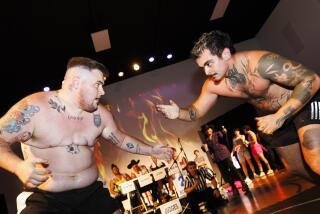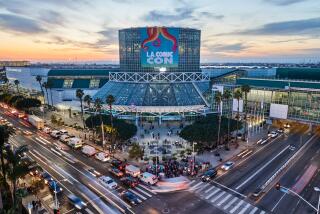Living large in L.A.
It’s morning in La-La Land, and the usual characters are roaming the star-studded sidewalks of Hollywood Boulevard. Supergirl is here; so are Catwoman and Zorro, clad in black and trademark masks.
Suddenly, an entourage of massive men in long robes, split-toed sandals and greased topknots stride down the sidewalk and stop before Grauman’s Chinese Theatre. The crowd of tourists stares uncertainly. Then they get it.
Sumo wrestlers! Real ones.
For the first time in 27 years, Grand Sumo -- the All-Star Game of this ancient sport -- has come to Los Angeles. And with it, 40 or so of Japan’s biggest and brightest sumo celebrities. These aren’t the amateur guys who wrestle in boxing shorts or the entertainers who show up at parties in inflatable fat suits.
Dressed according to rank, toned by intense training and bearing miens both dignified and playful, these men are the authentic heirs to Japan’s 1,500-year-old iconic sport of sumo.
“They’re real!” shrieked Mary Luca, 28, a Hollywood sidewalk entertainer clad in a red pirate costume. “I thought they were just dressing up!”
With grand spectacle steeped in vestiges of Japan’s ancient Shinto religion and martial arts, the sumo wrestlers opened their two-day sumo tournament at the Los Angeles Sports Arena on Saturday to a crowd of more than 10,000 fans.
Solemn wrestlers paraded down the aisles and onto the small stage at the arena’s center, elaborate ceremonial aprons strapped over their mawashi, or sumo belts. To the clicking of a wooden instrument, they circled, turned outward and circled again.
The two grand champions, who are Mongolian, were by far the biggest crowd-pleasers, judging from the roars as they were introduced.
Two by two, stripped to their belts, the wrestlers faced off in an ages-old choreography.
Each match began with a polite bow and a graceful squat. In a flash, the pair were bound in a fierce grip, one man attempting to force the other to the ground or outside the ring. Once, two wrestlers toppled in tandem to the floor while wrapped together. Three dignified dark-gowned judges appeared on stage and conferred briefly. The men fell at the same time and would face off in a rematch, they deemed.
The intense matches capped two lightweight days on the tourist circuit: visiting Hollywood Boulevard, touring Universal Studios, attending a Dodgers baseball game, hitting parties and shopping for extra-extra-large clothes.
And everywhere this group of huge men walked, people gawked and grinned at the collective sight of body mass -- more than 6 tons all told.
The wrestlers, who typically travel between official tournaments in Japan and exhibitions to promote the sport abroad and in smaller Japanese cities, are well accustomed to the limelight. They obligingly signed autographs, posed for pictures, got hugs and even kisses.
But they also did some gawking of their own, snapping photos of the Hollywood theater marquees, planting their feet into the footprints of George Clooney and other stars, and hamming it up, as a phalanx of Japanese journalists recorded every second.
In Hollywood, popular Japanese wrestler Takamisakari -- nicknamed “RoboCop” in Japan -- clowned around with the crowd, lifting up Supergirl and striking a triumphant “Rocky” victory pose over the footprints of Sylvester Stallone.
“I watch movies a lot and feel Hollywood’s energy,” Takamisakari said.
Hollywood, in fact, topped the list of images many wrestlers said they had of Los Angeles. Bulgarian sumo star Kotooshu -- known as the “David Beckham of sumo” for his boyish good looks -- said his most anticipated free-time activity here was attending a party, possibly with some celebrities.
For men who tip the scales at 300-plus pounds, one oft-mentioned marvel was America’s proclivity for supersizing.
In his blog from L.A., wrestler Kotoshogiku posted a picture of a massive slab of meat and a huge iced platter of sashimi and shrimp from the group’s welcome reception meal. “This is American size! Everything is BIG!” he wrote.
Sipping an iced latte at a Starbucks downtown, wrestler Tamakasuga asked for directions to the nearest Wal-Mart so he could experience a U.S. superstore and find American-size clothes that fit him. Over at Universal Studio’s CityWalk, Kotooshu managed to snare a size 40 pair of shorts and a 2-XL T-shirt.
At Universal Studios, Kotooshu and a couple of other wrestlers not only posed with Shrek, they also lifted him off his feet and mugged for the cameras. Plans for them to ride the Jurassic Park and Mummy attractions were shelved because the lap bar would not have been able to safely close over their girth, according to a Universal Studios spokeswoman.
Enrique Huerta, a 15-year-old student at West Ranch High School in Stevenson Ranch, was lucky enough to get a hug from Aminishiki, a 306-pound behemoth.
Huerta, like several other Angelenos interviewed, said they were familiar with sumo, having seen it on TV, the Internet or while visiting or working in Japan.
“They’re so cool -- they have to be so big and strong,” Huerta said. “But they look and feel like teddy bears.”
The tournament was the brainchild of Shigemitsu Inohana, a retired Japanese businessman who lives in Maui. Inohana said he wanted to show Americans authentic Japanese culture.
“Sumo is not just a sport,” Inohana said. “This is traditional culture with a long history.”
The wrestlers aren’t just fatties but powerful athletes who rigorously train day and night, building both enormous strength and the flexibility to touch their noses to the ground in full splits. Codes of honor, respect and dignity in performing the sport are also critical, they say.
“It’s not just two fat guys going at it,” said Musashimaru, a Samoa native who wrestled for 15 years and rose nearly to the top of the sumo world before retiring a few years ago and who is now an oyakata, or coach.
“The point isn’t just to win or lose,” said wrestler Yotsuguruma, 29. “It’s to do your best with the appropriate courtesy and etiquette. You should never gloat when you win. And even if you lose, you feel thankful to your opponent for what you can learn from him.”
According to the Japan Sumo Assn., the earliest matches were rituals dedicated to the gods for a bountiful harvest. In the 8th century, sumo became part of festivities for the Imperial Court, then was used to develop warrior training techniques under subsequent military governments.
Sumo as practiced today has evolved in the last 400 years. The contest seems simple enough, with victory determined by the wrestler who is the first to throw his opponent out of the ring or get him to touch the ground with any part of the body.
And, for professional wrestlers, sumo is an all-encompassing way of life that requires communal living in groups known as stables, governed by feudalistic and hierarchical rules that require, for instance, lower-ranking wrestlers to cook, clean and serve higher-ranking ones.
Despite the centuries of tradition, Japanese sumo is undergoing a noticeable change: an influx of foreigners. While Hawaiians blazed the way to open up Japan’s once-insular sumo world, the Los Angeles tournament features two Mongolians and a Bulgarian as three of the top stars.
But the decorum and strict rules that govern sumo wrestlers did not prevent them from hanging out and having fun during their pre-match sightseeing in Los Angeles.
In Hollywood, Kotooshu good-naturedly sparred with Idris Otaly, a 25-year-old tour guide. Otaly did a sumo stomp, then barreled into the 6-foot-8 Kotooshu, all 334 pounds of him.
“Man, you’re big!” Otaly told the smiling sumo star.
--
More to Read
Sign up for The Wild
We’ll help you find the best places to hike, bike and run, as well as the perfect silent spots for meditation and yoga.
You may occasionally receive promotional content from the Los Angeles Times.







